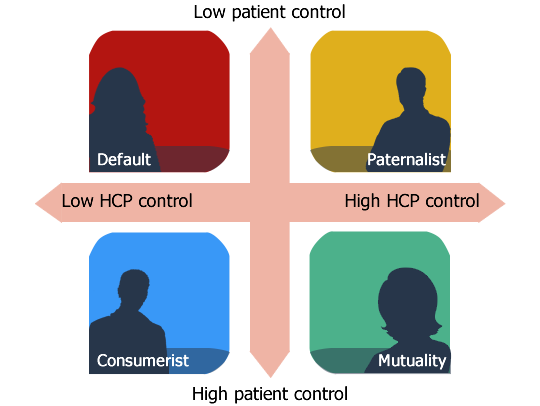Ask

Broach the topic, set the agenda: Broaching the subject
One of the main bottle necks that stops clinicians having helpful conversations about a patient’s weight is that we simply find it difficult to broach the topic tactfully. This is a socially taboo topic to broach in normal conversation, and it is useful to learn tools to do this well within a medical consultation.
Consider how you might broach the topic with an otherwise healthy obese adult.
The illustration shows where the four approaches sit in relation to the patient's control and the HCP's control. The ideal approach is 'mutuality' because it makes the patient feel in control and the HCP can also engage them
Hover over the plus icons to see a quote that demonstrates each approach.

Default
I’d like to talk about it but I’m too embarrassed
Consumerist
What are you going to do about my weight?
Paternalist
I want to talk about your weight
Mutuality
Can I ask you about your weight?
Roter & Hall, 1996
Below are the four different approaches.
Default
This is where neither the patient nor the healthcare professional are engaged in addressing obesity.
Paternalist
This is where the healthcare professional takes the lead without respecting the autonomy of the patient. It might be characterized by statements like "I am really concerned about your weight and I would like to have a discussion about it."
Consumerist
This is where the HCP is passive and does not broach the subject but waits for the patient to come asking for help. It might be characterized by patient statements like "I hear the NHS can help with my weight, what can you offer me?"
Mutuality

This is the ideal where both the healthcare professional and the patient agree to engage in the topic. It is proactively broached by the HCP, but the decision on whether to talk about weight is left to the patient. It is characterized by statements like "Can I ask you about your weight?"
Patient Scenario: Beverley

Patient Details
- Name: Beverley Buthelezi
- Age: 24
- Ethnicity: Black South African
- BMI: 35
- Family Background: family history of hypertension and heart disease
- Last Appointment: 1 year and 3 months ago
Summary
Beverley attends your clinic for contraceptive advice. She appears to have gained a considerable amount of weight since you last saw her.
She says she feels generally fit and well.
Reflections
Our analysis of consultations showed that some students preferred the indirect route (e.g. ”the computer says we need to have a conversation about your weight”), however this does not put the patient in control of the consultation. Patients are generally well aware of their weight (you are not breaking bad news) and know why you are asking to weigh them. Students that tried the direct but more patient-centred route found this to be well received by patients.
Below are some reflections by student doctors on using this method for broaching obesity with a patient:

One of the things that worried me, was how I would broach the subject of the patient's weight without disrupting rapport. However, I found in practice it was not actually as difficult as I had perceived.

I opened up the conversation with the question "may I ask you about your weight?", which was suggested in one of the campus block lectures and it felt really easy and appropriate to use. She replied with a very enthusiastic "yes!"

I learnt that patients with weight problems may want to talk about their weight and may even be relieved if the doctor raises the issue. Consequently in future I will feel less trepidation about raising the issue with a patient.
